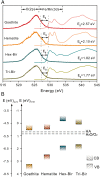Photoelectric conversion on Earth's surface via widespread Fe- and Mn-mineral coatings
- PMID: 31010932
- PMCID: PMC6525476
- DOI: 10.1073/pnas.1902473116
Photoelectric conversion on Earth's surface via widespread Fe- and Mn-mineral coatings
Abstract
Sunlight drives photosynthesis and associated biological processes, and also influences inorganic processes that shape Earth's climate and geochemistry. Bacterial solar-to-chemical energy conversion on this planet evolved to use an intricate intracellular process of phototrophy. However, a natural nonbiological counterpart to phototrophy has yet to be recognized. In this work, we reveal the inherent "phototrophic-like" behavior of vast expanses of natural rock/soil surfaces from deserts, red soils, and karst environments, all of which can drive photon-to-electron conversions. Using scanning electron microscopy, transmission electron microscopy, micro-Raman spectroscopy, and X-ray absorption spectroscopy, Fe and Mn (oxyhydr)oxide-rich coatings were found in rock varnishes, as were Fe (oxyhydr)oxides on red soil surfaces and minute amounts of Mn oxides on karst rock surfaces. By directly fabricating a photoelectric detection device on the thin section of a rock varnish sample, we have recorded an in situ photocurrent micromapping of the coatings, which behave as highly sensitive and stable photoelectric systems. Additional measurements of red soil and powder separated from the outermost surface of karst rocks yielded photocurrents that are also sensitive to irradiation. The prominent solar-responsive capability of the phototrophic-like rocks/soils is ascribed to the semiconducting Fe- and Mn (oxyhydr)oxide-mineral coatings. The native semiconducting Fe/Mn-rich coatings may play a role similar, in part, to photosynthetic systems and thus provide a distinctive driving force for redox (bio)geochemistry on Earth's surfaces.
Keywords: birnessite; mineral coatings; phototrophic; redox (bio)geochemistry; solar energy.
Conflict of interest statement
The authors declare no conflict of interest.
Figures




Similar articles
-
Natural Extracellular Electron Transfer Between Semiconducting Minerals and Electroactive Bacterial Communities Occurred on the Rock Varnish.Front Microbiol. 2019 Mar 4;10:293. doi: 10.3389/fmicb.2019.00293. eCollection 2019. Front Microbiol. 2019. PMID: 30886603 Free PMC article.
-
Effects of Manganese Oxide on Arsenic Reduction and Leaching from Contaminated Floodplain Soil.Environ Sci Technol. 2016 Sep 6;50(17):9251-61. doi: 10.1021/acs.est.6b01767. Epub 2016 Aug 10. Environ Sci Technol. 2016. PMID: 27508335
-
Impact of birnessite on arsenic and iron speciation during microbial reduction of arsenic-bearing ferrihydrite.Environ Sci Technol. 2014 Oct 7;48(19):11320-9. doi: 10.1021/es5031323. Epub 2014 Sep 22. Environ Sci Technol. 2014. PMID: 25243611
-
Redox chemistry of vanadium in soils and sediments: Interactions with colloidal materials, mobilization, speciation, and relevant environmental implications- A review.Adv Colloid Interface Sci. 2019 Mar;265:1-13. doi: 10.1016/j.cis.2019.01.002. Epub 2019 Jan 14. Adv Colloid Interface Sci. 2019. PMID: 30685738 Review.
-
Dissimilatory Fe(III) and Mn(IV) reduction.Adv Microb Physiol. 2004;49:219-86. doi: 10.1016/S0065-2911(04)49005-5. Adv Microb Physiol. 2004. PMID: 15518832 Review.
Cited by
-
Biocatalytic conversion of sunlight and carbon dioxide to solar fuels and chemicals.RSC Adv. 2022 Jun 6;12(26):16396-16411. doi: 10.1039/d2ra00673a. eCollection 2022 Jun 1. RSC Adv. 2022. PMID: 35754911 Free PMC article. Review.
-
Soil Respiration of Paddy Soils Were Stimulated by Semiconductor Minerals.Front Plant Sci. 2022 Jun 27;13:941144. doi: 10.3389/fpls.2022.941144. eCollection 2022. Front Plant Sci. 2022. PMID: 35832219 Free PMC article.
-
Photocatalytic Material-Microbe Hybrids: Applications in Environmental Remediations.Front Bioeng Biotechnol. 2022 Jan 31;9:815181. doi: 10.3389/fbioe.2021.815181. eCollection 2021. Front Bioeng Biotechnol. 2022. PMID: 35174148 Free PMC article. Review.
-
An ecophysiological explanation for manganese enrichment in rock varnish.Proc Natl Acad Sci U S A. 2021 Jun 22;118(25):e2025188118. doi: 10.1073/pnas.2025188118. Epub 2021 Jun 14. Proc Natl Acad Sci U S A. 2021. PMID: 34161271 Free PMC article.
-
Novel energy utilization mechanisms of microorganisms in the hydrosphere.Fundam Res. 2024 Feb 8;5(4):1584-1596. doi: 10.1016/j.fmre.2023.12.014. eCollection 2025 Jul. Fundam Res. 2024. PMID: 40777794 Free PMC article. Review.
References
-
- Foukal P, Fröhlich C, Spruit H, Wigley TML. Variations in solar luminosity and their effect on the Earth’s climate. Nature. 2006;443:161–166. - PubMed
-
- Dau H, Zaharieva I. Principles, efficiency, and blueprint character of solar-energy conversion in photosynthetic water oxidation. Acc Chem Res. 2009;42:1861–1870. - PubMed
-
- Katan J. Solar heating (solarization) of soil for control of soilborne pests. Annu Rev Phytopathol. 1981;19:211–236.
-
- Des Marais DJ. When did photosynthesis emerge on Earth? Science. 2000;289:1703–1705. - PubMed
Publication types
LinkOut - more resources
Full Text Sources

